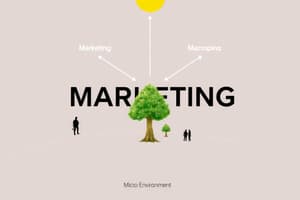Podcast
Questions and Answers
Which of the following is NOT considered a component of the microenvironment affecting a company's marketing efforts?
Which of the following is NOT considered a component of the microenvironment affecting a company's marketing efforts?
- Competitors
- Marketing intermediaries
- Economic forces (correct)
- Suppliers
How do demographic changes primarily affect marketing decisions?
How do demographic changes primarily affect marketing decisions?
- By affecting the geographical locations of sales
- By altering the company's pricing strategies
- By influencing the types of products offered in the market
- By changing consumer preferences and market segments (correct)
Which environmental force is primarily involved in technological advancements and their impact on marketing?
Which environmental force is primarily involved in technological advancements and their impact on marketing?
- Technological forces (correct)
- Natural forces
- Political forces
- Cultural forces
In what way can companies effectively react to changes in the marketing environment?
In what way can companies effectively react to changes in the marketing environment?
Which of the following is considered a macroenvironmental factor?
Which of the following is considered a macroenvironmental factor?
What is the primary aim of L’Oréal in building long-term supplier relationships?
What is the primary aim of L’Oréal in building long-term supplier relationships?
Which of the following is NOT considered a type of marketing intermediary?
Which of the following is NOT considered a type of marketing intermediary?
Which public category includes individuals or groups that directly impact a company's ability to achieve goals?
Which public category includes individuals or groups that directly impact a company's ability to achieve goals?
What is the primary purpose of competitors in the microenvironment?
What is the primary purpose of competitors in the microenvironment?
Which market type is explicitly identified as part of the customer segment?
Which market type is explicitly identified as part of the customer segment?
What is the main focus of generational marketing?
What is the main focus of generational marketing?
Which generation is primarily characterized as being born between 1981 and 1996?
Which generation is primarily characterized as being born between 1981 and 1996?
What demographic change might impact marketing decisions significantly?
What demographic change might impact marketing decisions significantly?
Which of the following demographic trends includes changes in family structures?
Which of the following demographic trends includes changes in family structures?
What defines the oldest demographic generation mentioned, Baby Boomers?
What defines the oldest demographic generation mentioned, Baby Boomers?
In marketing, how do age demographics relate to consumer choices?
In marketing, how do age demographics relate to consumer choices?
What is a possible implication of focusing marketing strategies only on Baby Boomers?
What is a possible implication of focusing marketing strategies only on Baby Boomers?
Which generational marketing aspect shifts as Baby Boomers and Millennials age?
Which generational marketing aspect shifts as Baby Boomers and Millennials age?
How does population diversity impact marketing strategies?
How does population diversity impact marketing strategies?
Why is understanding the demographic environment crucial for marketers?
Why is understanding the demographic environment crucial for marketers?
The microenvironment includes larger societal forces that affect a company's ability to serve its customers.
The microenvironment includes larger societal forces that affect a company's ability to serve its customers.
Demographic, economic, natural, and technological forces are considered part of the macroenvironment.
Demographic, economic, natural, and technological forces are considered part of the macroenvironment.
Suppliers are categorized as actors in the microenvironment.
Suppliers are categorized as actors in the microenvironment.
Marketing management does not need to consider other company groups while designing marketing plans.
Marketing management does not need to consider other company groups while designing marketing plans.
Cultural forces in the macroenvironment have no impact on marketing decisions.
Cultural forces in the macroenvironment have no impact on marketing decisions.
L'Oréal aims to build relationships with suppliers based solely on price.
L'Oréal aims to build relationships with suppliers based solely on price.
Marketing intermediaries include firms that assist in promoting and distributing goods.
Marketing intermediaries include firms that assist in promoting and distributing goods.
Any group that affects an organization's goals can be defined as a public.
Any group that affects an organization's goals can be defined as a public.
Financial publics are a type of marketing intermediary.
Financial publics are a type of marketing intermediary.
Competitors in the microenvironment must position their offerings against other firms.
Competitors in the microenvironment must position their offerings against other firms.
Flashcards are hidden until you start studying
Study Notes
Marketing Environment
- Marketing Environment: The actors and forces outside marketing that influence the ability to build and maintain successful relationships with target customers.
- Microenvironment: Consist of actors closest to the company that affect its ability to serve customers. This includes the company itself, suppliers, marketing intermediaries, customer markets, competitors, and publics.
- Macroenvironment: Includes the larger societal forces that impact the microenvironment. This includes demographic, economic, natural, technological, political, and cultural forces.
Company
- In designing marketing plans, marketing management takes into account other company groups like top management, finance, research and development, IT, purchasing, operations, human resources, and accounting.
Suppliers
- Suppliers provide resources to produce goods and services.
- They are treated as partners in providing customer value.
Marketing Intermediaries
- Firms that support the company in promoting, financing, selling, and distributing goods.
- Include resellers, physical distribution firms, marketing services agencies, and financial intermediaries.
Competitors
- Companies must position their offerings strategically to differentiate themselves from competitors in the minds of consumers.
Publics
- Any group that has an interest in or impact on an organization's ability to meet its objectives.
- Includes financial publics, media publics, government publics, citizen-action publics, local publics, the general public, and internal publics.
Customers
- Include consumer markets, business markets, reseller markets, government markets, and international markets.
Demographic Environment
- Demography studies human populations' size, density, location, age, gender, race, occupation, and other characteristics.
- Demographic trends include changing age and family structures, geographic population shifts, educational characteristics, and population diversity.
- Generations: Baby Boomers (1946-1964), Generation X (1965-1980), Millennials (1981-1996), Generation Z (1997-2012), and Generation Alpha (born after 2012).
The Economic Environment
- The economic environment influences consumer buying power and spending patterns.
- Consumers adopted a back-to-basics sensibility in their lifestyles and spending patterns, leading companies like Target to emphasize value propositions.
The Natural Environment
- This includes the physical environment and natural resources used by marketers or impacted by marketing activities.
- Trends in natural environments include growing shortages of raw materials, increased pollution, increased government intervention, and developing environmentally sustainable strategies.
- Environmental Sustainability: Involves creating a sustainable world economy.
The Technological Environment
- The most dramatic and rapidly changing force impacting the marketplace.
- Creates new products and opportunities while also prompting concerns about the safety of new products.
The Political and Social Environment
- Legislation regulates business to protect companies from each other, consumers from unfair practices, society's interests against unrestrained business behavior, and to emphasize ethics and socially responsible actions.
- Cause-Related Marketing: Companies link their products to a cause that consumers care about.
The Cultural Environment
- Includes institutions and forces that affect a society's basic values, perceptions, and behaviors.
- Core Beliefs and Values: Persistent beliefs passed on from parents to children and reinforced by various institutions.
- Secondary Beliefs and Values: More open to change and include views of oneself, others, organizations, society, nature, and the universe.
Reacting to the Marketing Environment
- Companies can react to the changing marketing environment by being proactive and taking steps to adapt and manage the forces that affect them.
- This includes analyzing environmental changes, developing strategies to adapt to these changes, and utilizing innovative marketing techniques to maintain their competitiveness.
Marketing Environment
-
The marketing environment consists of actors and forces outside marketing that impact a company's ability to build and maintain relationships with customers.
-
The microenvironment comprises actors close to the company that affect its ability to serve customers. This includes the company, suppliers, marketing intermediaries, customer markets, competitors, and publics.
-
The macroenvironment includes larger societal forces that influence the microenvironment. These forces include demographic, economic, natural, technological, political, and cultural forces.
Microenvironment
-
Company: Marketing management considers other company groups, including finance, research and development (R&D), information technology, purchasing, operations, human resources, and accounting.
-
Suppliers: Offer resources for producing goods and services. Building strong supplier relationships helps create customer value.
-
Marketing Intermediaries: Assist in promoting, financing, selling, and distributing products to end buyers. Examples include resellers, physical distribution firms, marketing services agencies, and financial intermediaries.
-
Competitors: Businesses must position their offerings effectively against competitors to gain a strategic advantage in the minds of consumers.
-
Publics: Any group with an actual or potential interest in or impact on an organization's ability to reach its goals. These include financial publics, media publics, government publics, citizen-action publics, local publics, the general public, and internal publics.
-
Customers: Companies must understand and serve different customer markets: consumer markets, business markets, reseller markets, government markets, and international markets.
Macroenvironment
-
Demographic Environment: The study of human populations—including size, density, location, age, gender, race, occupation, and other characteristics.
-
Economic Environment: Factors influence consumer spending patterns and decision-making. Shifts in buying power and economic trends influence marketing strategies.
Demographic Trends
-
Generations:
- Baby Boomers: Born between 1946 and 1964.
- Generation X: Born between 1965 and 1980.
- Millennials: Born between 1981 and 1996.
- Generation Z: Born between 1997 and 2012.
- Generation Alpha: Born after 2012.
-
Generational Marketing: Tailoring marketing strategies to specific generations based on their lifestyles and life stages.
-
Work-Life Balance: The rise of remote work and flexible work schedules impacts consumer behaviors and creates new marketing opportunities.
-
Marketing to Consumers with Disabilities: Companies are increasingly focusing on inclusivity and addressing the needs of consumers with disabilities.
Natural Environment
-
Focuses on the physical environment and natural resources needed for production or affected by marketing activities.
-
Trends in the Natural Environment:
- Growing shortages of raw materials.
- Increased pollution.
- Increased government intervention.
- Strategies for environmental sustainability.
-
Environmental Sustainability: Implementing practices and strategies that create a world economy that the planet can support indefinitely.
Technological Environment
- The technological environment is a powerful driver of market change.
- It creates opportunities for new products, services, and marketing strategies.
- Companies must address concerns about the safety of new technologies and products.
Political and Social Environment
-
Legislation regulates business to protect companies from each other, consumers from unfair practices, and society's interests from unrestrained business behavior.
-
Ethics and Socially Responsible Actions: Companies are increasingly focused on ethical and socially responsible business practices.
-
Cause-Related Marketing: Companies support charitable causes to build positive associations and enhance their image.
Cultural Environment
- The cultural environment impacts people's values, perceptions, and behaviors.
- Core Beliefs and Values: Enduring beliefs passed down from parents and reinforced by institutions.
- Secondary Beliefs and Values: More open to change, influencing people's views of themselves, others, organizations, society, nature, and the universe.
Adapting to the Marketing Environment
- Companies can react to the marketing environment through a combination of proactive and reactive strategies.
- This includes anticipating changes, adapting marketing strategies, and influencing the environment to their advantage.
Studying That Suits You
Use AI to generate personalized quizzes and flashcards to suit your learning preferences.




